#niccolo dell'arca
Explore tagged Tumblr posts
Text



Triptyques bolonais 5/8 : Bologna la Pieta (Bologne la douloureuse). Eglise Santo Stephano, eau bénite, la lamentation du Christ - Sanctuaire Santa Maria della Vitta.
#bologne#bologna#italy#italie#italia#pieta#religion#catholiscism#catholique#eglise#chiesa#church#lamentation#deploration#terre cuite#terracotta#niccolo dell'arca#sculpture#eau benite#aqua santa#covid19#sans contact#coronavirus
1 note
·
View note
Text
ok so there's this sculpture, and i know nothing about sculptures save like the very famous ones, and i like it a lot.
(this is me just free flowing my thoughts as they come. it got kind of long, so open at your own discretion i guess.)
so the piece is called "lamentation over the dead christ". in christian art they do that thing fanartist would do back in like 2015 where they'd draw a specific moment from a gameplay video. same thing here, but with the bible instead. think the crusification of jesus, all the different paintings and sculptures of that. or pieta, the scene where, after taking him off the cross, mary is holding and cradling jesus' dead body. that's what "la pieta" by michelangelo is depicting. anyway,
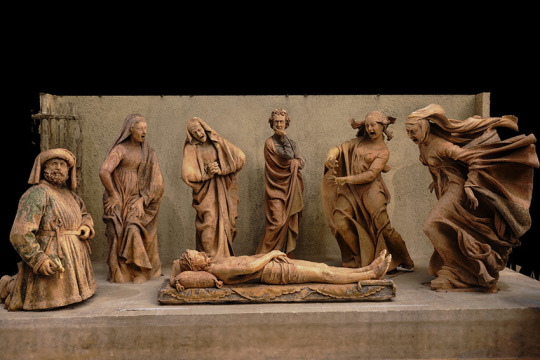
this piece by niccolo dell'arca shows jesus after he's been taken down the cross and has been rid of the wooden stakes. he's laying down on the ground surrounded in a half circle by a group of figures who are expressing horror over the death of the son of god, y'know, it's a big deal and whatnot. so you have this half circle which creates a really nice flow for the piece, for the composition, but also, more importantly, for the flow in emotional depth in the figures.
you start of with this guy, joseph, who's equipped with tools in both his belt and his hand, so it's implied essentially that he's the one to have removed the wooden stakes from jesus' hands and feet. he has this poised and composed look, held together strongly. he's the only one staring out, towards the viewer, almost pushing you to bare witness to the death of jesus and what that means. i'm not religious, but its still interesting, y'know the thought behind details is always a fascinating part in art. next to him you have this woman, salome, i don't know who she is either. she has this pose of buckled knees, fingers spread and digging into the thighs. her pose alongside mary's, who's next to her, are really fucking nice. mary's especially is my favourite between the two, with her clasped hands pushing towards the chest, elbows pointing outwards, as this sorrowful expression with the mouth open mid-cry. just.. aughh. seeing depictions of such human poses, mundane, no embellishments, i live for that shit.
next is saint john. he's a guy. a dude, even. y'know how back in the day women would do these shows of hysterics, with loud cries and begging, at someone's death/funeral (they still happen sometimes today, i know, but it's rare), and men were of course forbidden in divulging in anything of the sorts. they had to remain composed, strong, like my guy joseph at the beginning. but its so cool with this fucking guy, john, because you see him physically trying to adhere to that social norm, hand on face trying to conceal, to forcefully compose, nostrils scrunched up, eyebrows furrowed, you see the physical, the muscles strongly in play trying to hold back the grief of witnessing the dead son of god. and even his overall pose kind of shows that, right? the pull back with the shoulder, this contrapposto, it's another manifestation of physically trying to hold back the grief. of course, he's failing. you see his face and it's almost like he's mid cry, swallowing it down. this entire piece is made in terracotta, which had become like a trend back in the renaissance, as it was pretty cheap and allowed for far more detail, like thin strands of hair for instance. terracotta could also be painted. you can see the remnants of the color in john's shirt, joseph's sleeves, kinda. so all these figures were at one point fully painted, bringing another layer of life to the piece. the point was to really make the scene feel as though real, the anguish, to prompt the viewer even further into fully engaging and joining the figures in the grief. its just really fucking cool to think about.
back to this shit. the piece de resistance, the last two figures: mary of something and mary magdalene. when looking at this piece, especially for the first time, your eyes will immediately go towards them, and its natural of course. they hold the most amount of dynamism in the piece, not with just their expressions (remember the intensity of physical grief is ever rising in the piece), but, as you see for yourself, their poses as well. now these two are fucking amazing; like i said, they hold the dynamism, the biggest displays of horror but they also hold a beautiful contrast.
both marys are running towards jesus with these wails of denial, right. but the mary of something else is trying to stop her galloping, her rush towards the body, a repelling denial of "no this cannot be true." she's in a semi contrapposto; we see and feel all the energy of her run trying to maintain the push forward in its moment, what with the way her front knee is holding the weight of the body, the way her hands are splayed out in front of her, trying to desperately block this truth, the pull-back of the upper half of her body, the cloth draped on her shoulder billowing in place with the abrupt stop in motion. look at the cloth on her head! ughhhhhhhhghghghgh.
speaking of cloth, mary fucking magdalene. my brother in (dead) christ, mary magdalene.
the hell do i even say, lads. she's running full sprint, horror perfectly etched on that open mouth scream, fingers spread open wide. both these gals are saying "this cannot be true" but magdalene's is the denial of rectification. it's as if she's ready to drop down on the ground and change reality to what it should be with those anguished hands, full of frightful energy. it's, it's fucking harrowing looking at her. the flow of wind coursing through her clothes, the fanning-out motion of it, oh brother, its so beautifully captured. look at the wave of her head scarf!
and all for a motherfucker in a "i had to do it to them" pose
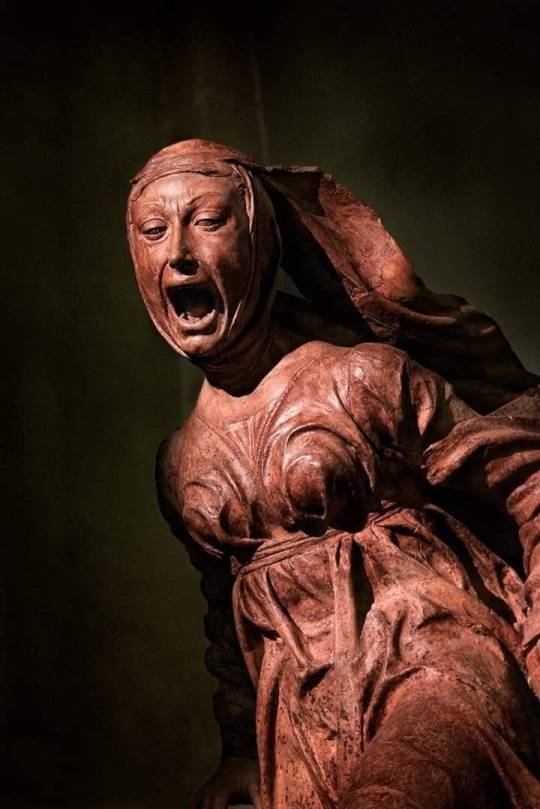
(pic credit: https://medium.com/@alejandro.orradre/lamentation-of-christ-niccolò-dellarca-b74c8e6f10a7) the lighting is of course adding a lot to the drama of the photo, kind of achieving a sort of a chiaroscuro effect maybe, but goodness gracious, look at this!
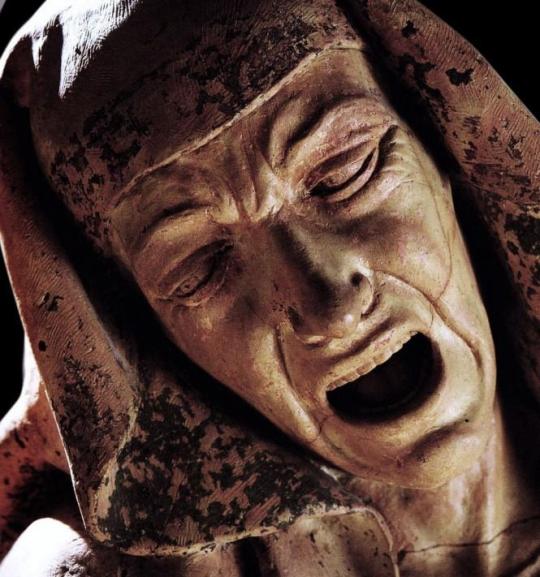
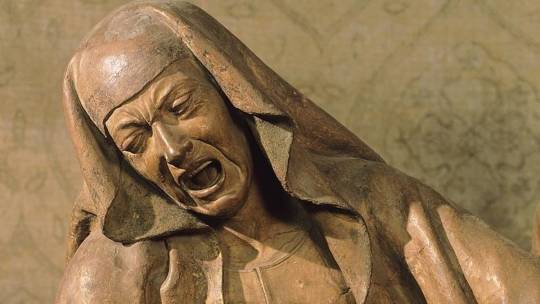
(second pic credit: https://medium.com/@alejandro.orradre/lamentation-of-christ-niccolò-dellarca-b74c8e6f10a7) this is mary's expression. you can almost hear the wails, perhaps the short bursts of grieving songs between the wails, just oh man.

look at this freaking guy. the wrinkles on the side of his nose as his face scrunches up in an attempt to save face. his lower eyelids, that careful look over the grim reality on the ground.
the amount of emotion depicted throughout this entire piece is kneecap breaking, it's beautiful. i've kind of run out of steam at this point, but yeah, this is a banger sculpture (group of sculptures?), i really like it. if you have any favourite sculptures that are not that well known, please tell me, i want to see more art.
#oldtxt#why does tumblr have such trouble with medium article links?#i tried putting the link in the photos and as a normal text link several times and it never stayed put#maybe the parsing gets confused by the @ sign in the link? i dunno. fucked up though.
10 notes
·
View notes
Photo
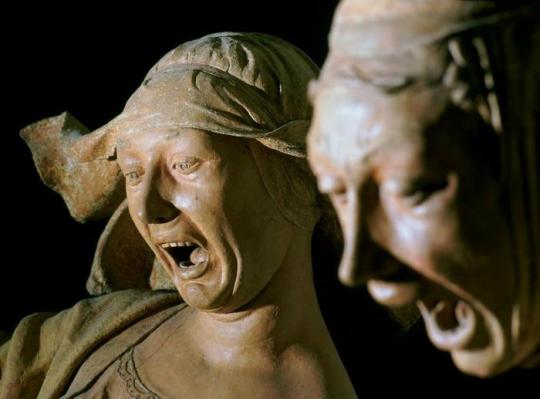
“The more we are united to God, the fuller we are of love. Now, if God cannot know anguish Himself, He can and does commiserate ours; for to pity the wretched and to pardon the guilty is a thing peculiar to Him.” – Bernard of Clairvaux [Mary of Cleopas and Mary Magdalen from Lamentation Over the Dead Christ by Niccolò dell’Arca]
• Man of the century! Woman of the century! You see such terms applied to so many today...that the line no longer has any punch. But Western Europe’s “man of the twelfth century,” without doubt or controversy, had to be Bernard of Clairvaux. Adviser of popes, preacher of the Second Crusade, defender of the faith, healer of a schism, reformer of a monastic Order, Scripture scholar, theologian, and eloquent preacher: any one of these titles would distinguish an ordinary man. Yet Bernard was all of these—and he still retained a burning desire to return to the hidden monastic life of his younger days. More: https://www.franciscanmedia.org/saint-of-the-day/saint-bernard-of-clairvaux
• They are so incredibly contemporary in their expression of pain and torment that I suddenly felt overwhelmed by the universal and timeless grief they express. I have seen that pain, many of us have experienced it, we know what it means. The only peaceful figure is that of Christ who looks serenely asleep on a decorative scalloped coverlet. More: https://www.italymagazine.com/when-600-years-old-statues-can-move-you-tears
#niccolo dell'arca#bernard of clairvaux#st bernard#mary magdalene#grief#holy saturday#triduum#tomb#mourning#lamentation#sculpture#compassion#passion sunday#death
2 notes
·
View notes
Photo
C'MON LUCKY SEVEN!

Compianto sul Cristo morto
Niccolò dell`Arca (1435-1494)
terracotta
Santuario di Santa Maria della Vita
Bologna/Italia
photo cjmn
727 notes
·
View notes
Photo

Compianto di Niccolo' dell'Arca 7 aprile 2017 #bologna #compianto #nicolodellarca (presso Bologna, Italy)
4 notes
·
View notes
Photo

La Pieta, by Niccolo dell'Arca, in the Santuario di Santa Maria della Vita di Bologna, Bologna, Italy, mid-late fifteenth century. Painted terracotta figures. The figures surrounding the dead Christ are, from left to right, Joseph of Arimathea, Mary Salome (mother of John), the Virgin Mary, John, Mary Cleophas, and Mary Magdalene. Image taken from ARTstor and figural description taken from here.
#niccolo dell'Arca#pieta#lamentation#lamentation over the dead christ#15th century art#Italy#italian#italian renaissance#italian art#terracotta#carving#sculpture#renaissance#early renaissance#joseph of arimathea#mary salome#virgin mary#mother of god#john the evangelist#mary cleophas#mary magdalene#sculptural group
26 notes
·
View notes
Photo

Mourning of the Marys over the Dead Christ (detail), Niccolo Dell'Arca, 1463
18 notes
·
View notes
Photo

Niccolo dell'Arca, Mourning of the Marias over the dead Christ, detail, c. 1462 (?) or c. 1485 (?).
#niccolo dell'arca#dell'arca#renaissance#italian art#art#sculpture#earl renaissance#italy#bologna#terracotta
51 notes
·
View notes
Photo

Pieta (detail), c. 1460
Niccolo dell'Arca
20 notes
·
View notes
Photo

Niccolo' dell'Arca, Dead Christ detail, terracotta, ca. 1460-1490, S. Maria della Vita, Bologna
15 notes
·
View notes
Photo
Luto por Cristo muerto.
Una escultura de Niccolò dell`Arca (1435-1494). Terracotta. Santuario di Santa Maria della Vita. Bolonia.

727 notes
·
View notes